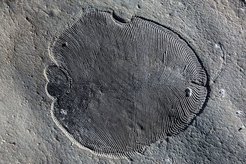558 million-year-old fat reveals earliest known animal
An international team of scientists has discovered molecules of fat in an ancient fossil to reveal the earliest confirmed animal in the geological record that lived on Earth 558 million years ago. The team was led by The Australian National University (ANU) and included scientists from the German Max Planck Institute for Biogeochemistry and University of Bremen as well as the Russian Academy of Science. Their recent results are published in the journal <i>Science.

“The fossil fat molecules that we’ve found prove that animals were large and abundant 558 million years ago, millions of years earlier than previously thought,” said Associate Professor Jochen Brocks, lead senior researcher from the ANU Research School of Earth Sciences. “Scientists have been fighting for more than 75 years over what Dickinsonia and other bizarre fossils of the Edicaran Biota were: giant single-celled amoeba, lichen, failed experiments of evolution or the earliest animals on Earth. The fossil fat now confirms Dickinsonia as the oldest known fossil belonging to the animal kingdom, solving a decades-old mystery that has been the Holy Grail of palaeontology.”
By analysing fat molecules the team developed a new approach to study Dickinsonia fossils, which hold the key between the old world dominated by bacteria and the world of large animals that emerged 540 million years ago during the ‘Cambrian explosion’. In that era complex animals and other macroscopic organisms – such as molluscs, worms, arthropods and sponges – began to dominate the fossil record. This is where Christian Hallmann and his team, experts in studies of fossil steroid molecules from the German Max Planck Institute for Biogeochemistry and the University of Bremen came into play. “We had to exclude that Dickinsonia could be protists, single-celled eukaryotes of the lowest organization level, a theory previously followed by others”, postdoctoral researcher Benjamin Nettersheim says. To this end they systematically studied the lipid composition of various rhizarian protists and artificially aged the biomass of these organisms to make them comparable to the fossils. “The pattern is completely different” says Hallmann, which clearly excludes this old theory.
“The problem that we had to overcome was finding Dickinsonia fossils that retained some organic matter,” said Mr Bobrovskiy from the ANU Research School of Earth Sciences. Most rocks containing these fossils such as those from the Ediacara Hills in Australia have endured a lot of heat, a lot of pressure, and then they were weathered after that. “Our fossils were located in the middle of cliffs of the White Sea that are 60 to 100 metres high and could only be reached by abseiling”. The unique preservation of Ediacara fossils at this remote locality may hold even far more clues towards the nature of our earliest animal ancestors.
